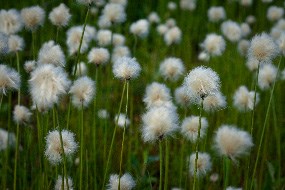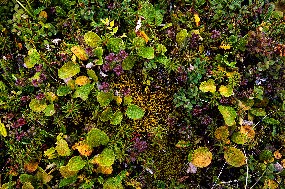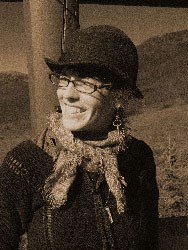
NPS Photo by Kent Miller Notes on Mud and Latin ERICA WATSON Beneath the ice
in its interminable thaw
streams improbable
but assuredly there—
these things contained,
not trapped by the world.
— Joan Naviyuk Kane, “In Long Light”
Last year, after the tourist season but before the snow fell, days of warm October rain saturated a sloped section of ground above the Denali National Park Road. The hillside collapsed, and slumped itself across the road in a wet, thawed heap. It was big news in the small communities surrounding the park, as the event combined at least two local favorites for what makes a good story: a dynamic landscape and a challenge posed to heavy equipment. The Associated Press reported to the nation, without editorializing, that “crews will take advantage of unseasonably mild weather conditions” and work seven days a week to clear the road. My partner Craig, a mechanic, returned from a day working overtime to repair a bulldozer and showed me pictures of Caterpillar-yellow front loaders dwarfed by the mass of mud on the road.

NPS Photo by Rob Burrows I didn’t see the effects of the landslide until the following spring, after the road had been cleared of both mud and the winter’s snow (not much, that year), but not yet opened to summer traffic: another in-between season. Waiting for my biking companions to catch up, I left the road and scrambled up the hillside in a manic springtime search for new life. I hoped the sunny slope just east of the signs warning against lingering too long in the slide area would reveal some early wildflowers. And it did: about thirty feet above the road, amidst the still-leafless willow shrubs and gray-brown tundra, I came across a few anemone blossoms. Their jerky swaying dance in the breeze illustrated their common name: windflower. These flowers are resourceful, showing up in the first patches of dry soil as soon as the sun is warm enough to support them. Early flowers seem simultaneously random and deliberate, the way they stake out the conditions needed to survive and open their petals to the spring’s wind, sun, and frost.
The little hump of tundra I shared with the windflowers felt firmly rooted in the hillside, but the swath of bare mud to my right served as a reminder of the landscape’s shiftiness. When I’d seen the aerial photos of the slide months earlier, my first thought had been of geological road kill. But Craig’s photos from his lunchtime climb up this same slope and the trickles of water I saw glistening on the newly exposed mud chute the slide left in its wake told me that death isn’t really the right metaphor for this kind of change. It’s something messier.
Geologists had determined that the slide’s material contained a layer of thawing, saturated permafrost, as well as the soil and vegetation on top of it. I thought about how, underneath me now, the same meltwater flowed off the mountain. So far, conditions remained for this particular section of hillside to keep its shape. The right combination of heat and water and nitrogen nurtured the windflowers. Should these conditions change, we might all tumble downward in a mess of water and mud and flowers. Like an earthquake, land flowing like water reminds us that nothing is reliably stable. It’s an uneasy reminder.
I took careful steps on the way down to my bike, as if it were my weight rather than the weight of water that might encourage this hill to give way to gravity. Like gravity and bedrock, permafrost gives shape to things, and the shapes are changing.
In the latitude and terrain around Denali, the region I call home, permafrost ranges between “discontinuous” and “sporadic,” meaning, roughly, it’s there in some places and not in others. These designations add something to its mystique; you can make a good guess about what’s underground based on how or if the trees grow and how tenacious puddles are after rain, but without a shovel and a lot of time to dig, you can’t quite be sure until it changes. Diagrams illustrating permafrost’s position on the earth’s surface show neatly defined layers marked as “active,” “frozen,” “unfrozen.” These diagrams are often followed by an acknowledgement that features like mountains and rivers disrupt the linearity of frozen ground, and that mountains and rivers also define the landscapes permafrost inhabits.
The English word is straightforward in origin: “perma,” or “perma(nent),” from the Latin “permanēre,” plus “frost,” meaning a state or condition of being or becoming cold, or the cold itself. On a page framed by the words “perlucidus” and “perpetrate,” Webster’s defines permafrost as “perennially frozen subsoil.” And to be considered permanently frozen, this underground combination of soil and water must withstand only two consecutive summers, but often lasts much longer.
Long-lasting cold like this is often associated with memory, with proof: remains of Pleistocene mammoths emerge from exposed permafrost, preserved as if they’d died more recently than 10,000 years ago, eyes and hair frozen in place. “Frozen” as in cold, and also immobilized, not going anywhere. This word makes cold and stillness synonymous.
Permafrost landscapes preserve details of another time in a way temperate ecologies don’t. In The Faraway Nearby, writer Rebecca Solnit weaves a parallel narrative of degenerative brain disease and a warming world, holes and fissures melting into both ice and brain tissue. Memories are lost with each process. Solnit writes that her mother’s Alzheimer’s “would have been less shocking if it had arrived suddenly, but she traveled so slowly it often seemed imperceptible until we reached another milestone.” Change often follows that progression of imperceptibility until, suddenly, it’s noticed, and the milestones are different depending on the perceptive tools available in a given situation. Arctic naturalist E. C. Pielou refers to the earth’s “thermal memory,” recorded and preserved in permafrost and glacial ice and explored by curious humans through bore holes and core samples. Elements aged and analyzed, mapped out alongside human milestones: the most atmospheric carbon in the time humans have inhabited the earth. The most nitrogen released from the soil since the first summer I spent learning the names of tundra flowers, categorizing them by color and latitude and month, each summer month its own mini-season at this latitude. 
NPS Photo by Jacob W Frank Alaska cotton grass (Eriophorum brachyantherum) has always been one of my favorites. Like windflowers, cotton grass is categorized as a white flower in my color-coded guide. They’re unmistakable with their un-flowerlike seed heads bobbing on thin sedge stalks, late June into August. If you’re looking at one of these wispy white tufts up close your feet are probably sinking into mud, water encircling your ankles. I like their subtle simplicity, which is, of course, not so simple.
I learned that cotton grass is notable for its love of nitrogen-rich soils. In places where thawing permafrost has released not only water but also nitrogen, which had previously been frozen underground, cotton grass thrives.
I learned about nitrogen and cotton grass from researchers who work at Eight-Mile Lake, just outside the northern boundary of Denali National Park. The temperature of the permafrost they study hovers right at freezing, making it particularly prone to slight warming. Their network of narrow boardwalks criss-crosses the tundra, leading to stations recording changes in temperature, carbon, nitrogen, and biomass, above and below ground. The boardwalk keeps human feet raised a few inches off the ground in order to prevent repeated travel from wearing a trail. The absorbent dark of a worn trail could accelerate the thawing of the permafrost below, and this would skew the data.
The goal in their research is to isolate variables in warming the ground. In some places, they’ve intentionally raised the temperature by building boxes like mini-greenhouses to trap heat close to the soil in summer. Shoveling snow artificially high in winter keeps the cold air temperatures from seeping down into the soil. These actions have thawed the permafrost beneath, and the glass boxes sit in shallow indentations, not dramatically different from the surrounding tussocks and troughs. Still, they’ve only been warming the soil here a few years, and those few degrees have made a real difference.
In addition to the slumped ground, the vegetation in the warmed areas is changing. Here and elsewhere in the north, increased cotton grass growth signals nitrogen in places where it hadn’t been, usually accompanied by dying moss. The thick, spongy layer of moss and leaves help insulate the ground below from heat in summer, or the deep cold of Arctic air in winter. In places where the moss has died or been worn away, the exposed ground often slumps into itself as the permafrost below thaws.
I visited Eight-Mile Lake in fall, the tundra painted in shades of orange and red, and all evidence of cotton grass was gone. The ground beneath the boardwalk feels how I’d expect it to: dry moss and lichens, scattered with red dwarf birch leaves blown from twig-like branches. In most places, it’s easy to dig into, making inexact and clumsy miniature boreholes with your fingers: still damp, still cold.
Even on the warmest summer days, you can count on that cold. Wet, dark cold that gets under your fingernails. Northern landscapes always remind you that it is cold that gives shape to things, even on days when heat ripples off the tundra in transparent waves, demonstrating the constant exchange between what’s above and what’s below.
Think of the way tundra hills roll out in waves, and with your own feet planted on the ground, the boundary between the hills and the sky makes a neat line of the horizon. It’s easy to think of surfaces as defined, clear-cut things, and what lies below or above them as easily separated into categories. Rocks and water transcend the boundaries, as can some small, burrowing animals. Heavy equipment, and shovels can, too, and thus the humans who use them. Denning bears. The list keeps growing. Still, we delineate the surface of the world, even as the boundaries are constantly challenged and permeated. Even as your feet sink slightly into the vegetation under the weight of your body. If you’re barefoot, maybe a toe is swallowed up by moss. Sit down on that tundra, feel the leaves, moss, and lichens crunch and snap beneath your weight. 
NPS Photo by Tim Rains At Eight-Mile Lake, I added nitrogen to my list of terrestrial boundary crossers. Of course there are places where the permeation and dissolution of soil layers are expressed on a larger scale than an indentation in the ground or a greater density of cotton grass where once none grew. But these small connections between the causes-and-effects and side-effects help fill in the holes in the story of what happens before a hillside flows onto a road and stops like a tired dog, or a tundra pond vanishes into the earth. As with memory loss, small signs are easy to miss without diligent observation.
I stood up on the boardwalk, elevated a few inches off the ground, as if the only impact I could have on this landscape is that of my boots wearing through the moss. As if the boundaries were that simple.
I came home, and opened up the Webster’s dictionary again. This is a big, old-school dictionary, the kind that does real damage if dropped on a bare toe, has weight sitting in your lap. It’s an attention-grabbing dictionary.
I’ve noticed certain repetitions in my discussions of permafrost, when I attempt to describe what it is and what it isn’t. “Permeate” appears frequently when I talk about what water doesn’t do to permafrost (except for when it does). “Permeate” is a short scroll down from “permafrost” in the first column, through a long string of “perm” words. It comes from the Latin verb, “permeāre,” meaning “to pass through.” I haven’t studied Latin, beyond these evenings with the dictionary; I could easily confuse this with the “permanēre” of permanence, of impassable substances. I think of permafrost full of holes and cracks, water passing through.
Definitions are misleading when you dig around in them, rearrange the pieces, shine light on the cracks. Water finds a way in, and soon, the whole endeavor is waterlogged. A slow leak seeps out the bottom and leaves a wet, circular stain on the table where the impermeable definition once stood. Maybe this is why I like definitions so much. They can contradict the very thing they set out to do, and demonstrate both the pleasure and futility of putting order to the world.
I looked back at “perlucidus,” the first entry on the page. The word refers to the type of cloud characterized by the spaces between visible vapors, what I often think of as “fish scale clouds.” Perlucidus is a weather word, a word borne of the need to describe the effects of warmth moving into cold, breaking things up, creating space.
And the last word, “perpetrate,” means “to perform, execute, or commit (a crime).” These words strike me as useful markers in understanding the shifting boundaries. As with thawing, now-permeable permafrost, somewhere between the conversations about weather patterns and who or what to blame, there are the actual, observable processes of a landscape shifting boundaries. These shifts demand reexamination of definitions, and of roads and buildings and memories of the places we build them. Of nitrogen, mud, and ice, and acknowledgement of the unexpected connections between them, and the spaces where the water and the light might trickle through.

Erica Watson has spent most of the past ten years living, working and playing on the boundary of Denali National Park. Her writing has appeared most recently in Vela and ISLE Journal, and she blogs (occasionally) at ericawatson.wordpress.com. She received her MFA in creative nonfiction writing from the University of Alaska Anchorage’s low-residency program in 2014.
|
Last updated: March 29, 2017
